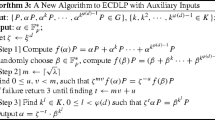Abstract
The discrete logarithm problem (DLP) in a group is a fundamental assumption that underpins the security of many systems. Hence evaluating its hardness is important. For efficient implementation of cryptographic algorithms, sometimes groups with additional structures are preferred. However, these structures may be used to obtain faster attacks. By using equivalence classes, Galbraith and Ruprai proposed a faster algorithm to solve the DLP in an interval of size N, with expected running time of \(1.361\sqrt{N}\) group operations. Liu generalized their algorithm to the 2-dimensional case, which required \(1.450\sqrt{N}\) group operations. Further, for an elliptic curve with an efficiently computable endomorphism, Liu reduced the complexity to \(1.026\sqrt{N}\). In this paper, we propose a variant of the Galbraith–Ruprai algorithm. This variant has average-case asymptotic complexity close to \(1.253\sqrt{N}\) for sufficiently large N. For certain practical parameters, the complexity is \(1.275\sqrt{N}\) in the 1-dimensional case and \(1.393\sqrt{N}\) in the 2-dimensional case. Then we extend the algorithm for the case of larger equivalence classes. In particular, for the 2-dimensional DLP in a rectangle on an elliptic curve with an efficiently computable endomorphism, we reduce the complexity to \(0.985\sqrt{N}\) for certain fixed parameters. We also discuss some possible further improvements.


Similar content being viewed by others
References
Bos J.W., Kleinjung T., Lenstra A.K.: On the use of the negation map in the Pollard rho method. In: Algorithmic Number Theory Symposium-ANTS 2010, pp. 66–82. Springer, Berlin (2010).
Galbraith S.D., Holmes M.: A non-uniform birthday problem with applications to discrete logarithms. Discret. Appl. Math. 160(10), 1547–1560 (2012).
Galbraith S.D., Ruprai R.S.: An improvement to the Gaudry–Schost algorithm for multidimensional discrete logarithm problems. In: Proceedings of the 12th IMA International Conference on Cryptography and Coding, pp. 368–382. Springer, Berlin (2009).
Galbraith S.D., Ruprai R.S.: Using equivalence classes to accelerate solving the discrete logarithm problem in a short interval. In: Public Key Cryptography-PKC 2010, pp. 368–383. Springer, Berlin (2010).
Galbraith S.D., Lin X., Scott M.: Endomorphisms for faster elliptic curve cryptography on a large class of curves. In: Advances in Cryptology-EUROCRYPT 2009, pp. 518–535. Springer, Berlin (2009).
Galbraith S.D., Pollard J.M., Ruprai R.S.: Computing discrete logarithms in an interval. Math. Comput. 82(282), 1181–1195 (2013).
Gallant R., Lambert R., Vanstone S.: Improving the parallelized Pollard lambda search on anomalous binary curves. Math. Comput. 69(232), 1699–1705 (2000).
Gallant R., Lambert R., Vanstone S.: Faster point multiplication on elliptic curves with efficient endomorphisms. In: Advances in Cryptology-CRYPTO 2001, pp. 190–200. Springer, Berlin (2001).
Gaudry P., Schost É.: A low-memory parallel version of Matsuo, Chao, and Tsujii’s algorithm. In: Algorithmic Number Theory Symposium-ANTS 2004, pp. 208–222. Springer, Berlin (2004).
Gennaro R.: An improved pseudo-random generator based on discrete log. In: Advances in Cryptology-CRYPTO 2000, pp. 469–481. Springer, Berlin (2000).
Gopalakrishnan K., Thériault N., Yao C.: Solving discrete logarithms from partial knowledge of the key. In: Progress in Cryptology-INDOCRYPT 2007, pp. 224–237. Springer, Berlin (2007).
Koblit N.: CM-curves with good cryptographic properties. In: Advances in Cryptology-CRYPTO’91, pp. 279–287. Springer, Heidelberg (1992).
Lim C.H., Lee P.J.: A key recovery attack on discrete log-based schemes using a prime order subgroup. In: Advances in Cryptology-CRYPTO’97, pp. 249–263. Springer, Berlin (1997).
Liu W.: Improved algorithms for the 2-dimensional discrete logarithm problem with equivalence classes. Master’s thesis, University of Auckland (2010).
Longa P., Sica F.: Four-dimensional Gallant–Lambert–Vanstone scalar multiplication. In: Advances in Cryptology-ASIACRYPT 2012, pp. 718–739. Springer, Berlin (2012).
Matsuo K., Chao J., Tsujii S.: An improved baby step giant step algorithm for point counting of hyperelliptic curves over finite fields. In: Algorithmic Number Theory Symposium-ANTS 2002, pp. 461–474. Springer, Berlin (2002).
Patel S., Sundaram G.S.: An efficient discrete log pseudo random generator. In: Advances in Cryptology-CRYPTO’98, pp. 304–317. Springer, Berlin (1998).
Pollard J.M.: Monte Carlo methods for index computation (mod \(p\)). Math. Comput. 32(143), 918–924 (1978).
Quisquater J.J., Delescaille J.P.: How easy is collision search? Application to DES. In: Advances in Cryptology- EUROCRYPT’89, pp. 429–434. Springer, Heidelberg (1990).
Shanks D.: Class number, a theory of factorization, and genera. In: Proceedings of Symposia in Pure Mathematics, pp. 415–440 (1971).
Smith B.: Families of fast elliptic curves from \(\mathbb{Q}\)-curves. In: Advances in Cryptology-ASIACRYPT 2013, pp. 61–78. Springer, Berlin (2013).
Teske E.: On random walks for Pollard’s rho method. Math. Comput. 70(234), 809–825 (2001).
van Oorschot P.C., Wiener M.J.: On Diffie-Hellman key agreement with short exponents. In: Advances in Cryptology-EUROCRYPT’96, pp. 332–343. Springer, Berlin (1996).
van Oorschot P.C., Wiener M.J.: Parallel collision search with cryptanalytic applications. J. Cryptol. 12(1), 1–28 (1999).
Weng A.: A low-memory algorithm for point counting on picard curves. Des. Codes Cryptogr. 38(3), 383–393 (2006).
Wiener M.J., Zuccherato R.J.: Faster attacks on elliptic curve cryptosystems. In: Selected Areas in Cryptography–SAC’98, pp. 190–200. Springer, Berlin (1998).
Acknowledgements
Funding was provided by National Natural Science Foundation of China (Grant Nos. 61502481 and 61672019). We would like to thank Professor Steven Galbraith for his helpful comments.
Author information
Authors and Affiliations
Corresponding author
Additional information
Communicated by S. D. Galbraith.
Rights and permissions
About this article
Cite this article
Zhu, Y., Zhuang, J., Yi, H. et al. A variant of the Galbraith–Ruprai algorithm for discrete logarithms with improved complexity. Des. Codes Cryptogr. 87, 971–986 (2019). https://doi.org/10.1007/s10623-018-0492-3
Received:
Revised:
Accepted:
Published:
Issue Date:
DOI: https://doi.org/10.1007/s10623-018-0492-3




